| |
Magdalena Sin Fronteras
Santa Clara, Cuba, January 2008
Cuba: land of Che and Fidel, of cigars and old cars, tiny thorn in the
great flank of western capitalism. And home to Estudio Teatral in Santa
Clara, organisers of Magdalena
Sin Fronteras, a festival gathering of
the Magdalena
Project.
They invited me to come to the festival. I asked Creative
New Zealand for the airfare and, to my surprise and delight, they
said yes.
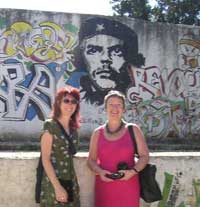 Cuba
is not an easy place to get to; organising my travel took a ridiculous
amount of time, so I decided that if I was going to go to all of this
effort, I needed to see more than the festival. What are my chances of
getting to Cuba again? I planned two days in Havana before the festival,
and a week afterwards, wherever I might end up. Cuba
is not an easy place to get to; organising my travel took a ridiculous
amount of time, so I decided that if I was going to go to all of this
effort, I needed to see more than the festival. What are my chances of
getting to Cuba again? I planned two days in Havana before the festival,
and a week afterwards, wherever I might end up.
I didn't have much time to prepare; my Spanish was minimal and rusty,
and most of what I knew about Cuba came from a few movies such as "How
Cuba Survived Peak Oil" and "Before
Night Falls". I understood a potted history of the revolution
and the consequences of the USA blockade, and I browsed Wikipedia.
I searched the internet for signs of alternative Cuba, of net.artists
or digital artists based in Cuba ... but found none.
And then I was there: standing at immigration and wondering whether
the three errors in my visa (involving my surname, date of birth and
nationality) were going to cause a problem. Wondering whether anyone
from the festival would be there to meet me, given that my flight was
an hour late and immigration was taking ages. But nobody minded
about the discrepancies between my visa and my passport, and on the other
side Maria from the National Association of Theatres and her son were
patiently waiting for me. They delivered me to a casa
paticulare (private house with guest rooms) where Jill Greenhalgh
and Gilly Adams had arrived the day before.
We had two days to check out Havana before the festival bus would take
us to Santa Clara.
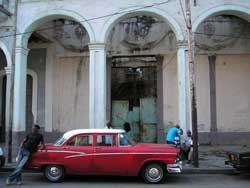 Havana
is a bustling city, but a bustle that involves no advertising
and much less traffic than most cities of similar size (population 3
million). And much more diverse traffic as well - gleaming
late model cars share the roads with dusty truck-buses, battered taxis,
beautiful old classics, bici-taxis and various horse-drawn conveyances.
Sacks are hung from the horses' rear ends to the front of vehicle
towed to catch what would otherwise render streets a stinking
mess. The streets are clean but pot-holed, the pavements are broken and
the buildings grand but mostly in poor repair - especially the hurricane-lashed
buildings on the water-front Malecon. And everywhere
there is graffiti - political slogans, billboards extolling the virtues
of the revolution and huge images of Che (and occasionally Fidel or Camillo,
but Che is obviously the best-looking). Havana
is a bustling city, but a bustle that involves no advertising
and much less traffic than most cities of similar size (population 3
million). And much more diverse traffic as well - gleaming
late model cars share the roads with dusty truck-buses, battered taxis,
beautiful old classics, bici-taxis and various horse-drawn conveyances.
Sacks are hung from the horses' rear ends to the front of vehicle
towed to catch what would otherwise render streets a stinking
mess. The streets are clean but pot-holed, the pavements are broken and
the buildings grand but mostly in poor repair - especially the hurricane-lashed
buildings on the water-front Malecon. And everywhere
there is graffiti - political slogans, billboards extolling the virtues
of the revolution and huge images of Che (and occasionally Fidel or Camillo,
but Che is obviously the best-looking).
After playing tourists in Havana, we escape for a day to the beaches
east of the city. Our driver and guide, Umberto, is an engineer but
he works as a taxi driver because the pay is better, due to the possibility
of getting tips in convertibles. Cuba operates a dual currency system:
Cuban pesos for Cubans, and Cuban convertible pesos, worth 24 Cuban pesos,
for tourists. At first the system seems bizarre and unfair, but there
is a logic to it: the redistribution of wealth.
And we visiting theatre artists are wealthy, in comparison to Cubans
whose salaries are the equivalent of about 10 to 20 US dollars a month.
Everyone has a job, housing, free health care, free education, and basic
food. But certain things, including petrol, many food items and most
"luxuries", can only be purchased with convertibles, making
it necessary for Cubans to operate in both economies if they aspire to
anything above the most basic standard of living. One exception is books,
which are incredibly cheap and sold in Cuban pesos - unless you chose
to shop at the over-priced outdoor book market in the touristic old town.
Step into a local bookstore and, as long as you read Spanish, you have
a wide selection of very affordable books.
The day for the festival to begin arrived, and a big yellow guagua (pronounced
"wah wah" - South American Spanish for bus) pulled up outside
our casa near enough to 8.30am for us to think the day was beginning
well. There was much delight as we were reunited with other Magdalenas
from different corners or the globe. Off we set - but two hours later
we still had not left the city; in fact we were almost back where we
started. Someone had forgotten a bag, then someone had to go to the toilet,
someone needed a cigarette, someone else needed to go to the toilet,
someone wanted coffee ... finally close to 11am the bus headed past various
national monuments for the second time and then out onto the Autopista,
bound for Santa Clara.
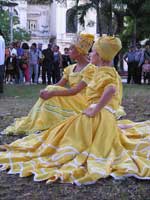 This
was the second festival organised by Roxana Piñeda
and her theatre company, Estudio Teatral de Santa Clara (the first
was in 2005). The programme featured about 20 performances, half
Cuban and half international, as well as workshops and forums. The opening
of the festival took place that evening in the town square, and featured
performances by a large number of young performing arts students - Afro-Cuban
dance followed by an all-male contemporary dance performance. It seemed
that the whole town had turned out for the opening, and throughtout the
festival there were consistently full houses. This
was the second festival organised by Roxana Piñeda
and her theatre company, Estudio Teatral de Santa Clara (the first
was in 2005). The programme featured about 20 performances, half
Cuban and half international, as well as workshops and forums. The opening
of the festival took place that evening in the town square, and featured
performances by a large number of young performing arts students - Afro-Cuban
dance followed by an all-male contemporary dance performance. It seemed
that the whole town had turned out for the opening, and throughtout the
festival there were consistently full houses.
We surrendered to festival mode - days full of workshops and forums,
evenings full of performances. I joined a dramaturgy workshop led by
Gilly Adams (Wales), which became more of a cultural exchange as the
group was roughly half European women and half Cuban
men, with one female Cuban participant, one Colombian man, and our translator
- who in her first year of study to be an interpreter. This was her
first work experience - a big challenge, as we were writing creatively
with lashings of metaphor, poetry, word play and irony. There was also
Antipodean me, and Luciana Bazzo, from Brasil but living in Denmark.
Through the exercises that Gilly set for us, we uncovered delicious details
about each other and our varied backgrounds and cultures. In just three
mornings, we had a very rich sharing.
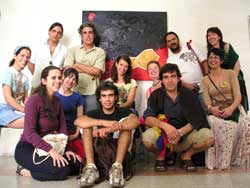
Every evening there were at least two
performances. One night we were taken to Mejunje,
the closest thing to an underground venue that I experienced in
Cuba. Contained within the walls of a long-gone building, open to the
sky and incorporating trees amongst the seating, Mejunje has earned a
reputation as an excellent alternative music and performance venue. The
owner made a speech, welcoming the Magdalena festival delegates, and
for some reason that my limited Spanish prevented me from understanding,
he presented a painting to another man. Then the show began - a solo
performance from Havana-based Estudio Vivarta. i was amazed to realise
that it was about Katherine
Mansfield. How strange to be sitting in an open-air theatre in Cuba
watching a performance about one of New Zealand's most internationally
famous writers. Later I spoke to the performer, who told me that she
had taken over the role from another performer who had left the company,
so she couldn't tell me why they had chosen to make a show about
Mansfield. It was a very physical piece, packed with imagery, anger and
energy - it would be great to bring to New Zealand.
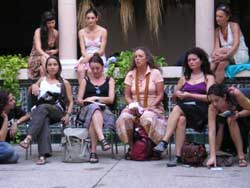 There
were forums every afternoon, during which different directors and
performers spoke about their personal theatrical journeys. Like the performances,
these were incredibly well attended - usually standing room only - with
high school students as well as local artists and academics. I was struck
by the contrast - how we struggle to get audiences for this kind of thing
at home, yet here people are hungry for theatre, for discussion, for
exchange. There are different priorities, different paces of life. There
were forums every afternoon, during which different directors and
performers spoke about their personal theatrical journeys. Like the performances,
these were incredibly well attended - usually standing room only - with
high school students as well as local artists and academics. I was struck
by the contrast - how we struggle to get audiences for this kind of thing
at home, yet here people are hungry for theatre, for discussion, for
exchange. There are different priorities, different paces of life.
My main role at this festival was to participate in the
second Women With Big Eyes collaboration; nine of us had
worked together at Transit
V in Denmark in January 2007, and a year later in Cuba there
were eight of the original group plus a few more joining in. Unfortunately
the festival programme only gave us three mornings to work and a presentation
slot, and because every day at least one person from the group was giving
a performance or work demonstration, we had a somewhat interrupted process.
But some of us were able to spend an extra afternoon experimenting with
the data projector and flexible mirror, and in the end we presented a work
of 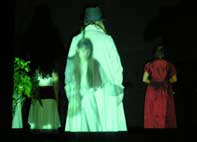 about
15 minutes that incorporated video and other elements from the previous
iteration with new material, some new people and new ideas. Once again,
the presentation proved to be very moving and rich for the audience.
What is interesting to me is that we have taken a story as a starting
point, deconstructed it, then fed in the things that each of us felt
important to bring to the work - and created something that the audience
can each individually read something in. It must be a combination of
the experience of everyone in the group along with the pressure-cooker
working method - there is no time to deeply explore, decisions must be
made quickly on instinct and practicality. And the result is powerful. about
15 minutes that incorporated video and other elements from the previous
iteration with new material, some new people and new ideas. Once again,
the presentation proved to be very moving and rich for the audience.
What is interesting to me is that we have taken a story as a starting
point, deconstructed it, then fed in the things that each of us felt
important to bring to the work - and created something that the audience
can each individually read something in. It must be a combination of
the experience of everyone in the group along with the pressure-cooker
working method - there is no time to deeply explore, decisions must be
made quickly on instinct and practicality. And the result is powerful.
As always, the networking and meeting with other like-minded
people from around the world is what makes Magdalena festivals such vital
experiences. It was wonderful to catch up with those I already knew
- I was staying at the same place as Jill, Gilly, Julia Varley, Geddy
Aniksdal and Lars Vik, Dah Theatre (Dijana Milošević, Maja Mitić and
Sanja Krsmanović Tasić) and Cristina Castrillo and Bruna Gusberti, which
was very nice and familar - and there were several others there I knew
from previous festivals. I made new connections with Elizabeth de Roza
(Singapore), Letícia
Castilho (Brazil) and many others, although not being able to speak Spanish
was really frustrating (if I could do anything different in my life,
I would learn as many languages as possible, from birth!). At the final
round when we were all asked to make one wish, I said yo
deseo hablar y entiendar español; so
now I really must learn it!
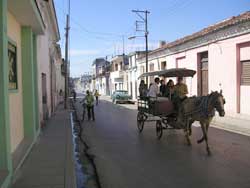 Ten
days of watching performances mostly in Spanish, struggling to catch
English translations of announcements at the end of the performances,
trying to order food and drinks in Spanish (actually the drinks are
easy) AND trying to take in all of the content of the workshops,
forums and performances, pushes one towards exhaustion. But moments of
unexpected beauty are the perfect antedote for exhaustion. One day we
visited the jubiladas (elderly women) in the casa
de las anciens (house for the ancients) next door to the theatre.
Roxana and her company are regular visitors, singing songs with their
neighbours, and many of the elderly women stood up to perform their own
special numbers. At the far end of the courtyard sat a chair-ridden old
woman who, when the music stirred her, waved her fist in the air and
cried, "Viva
Fidel!" Ten
days of watching performances mostly in Spanish, struggling to catch
English translations of announcements at the end of the performances,
trying to order food and drinks in Spanish (actually the drinks are
easy) AND trying to take in all of the content of the workshops,
forums and performances, pushes one towards exhaustion. But moments of
unexpected beauty are the perfect antedote for exhaustion. One day we
visited the jubiladas (elderly women) in the casa
de las anciens (house for the ancients) next door to the theatre.
Roxana and her company are regular visitors, singing songs with their
neighbours, and many of the elderly women stood up to perform their own
special numbers. At the far end of the courtyard sat a chair-ridden old
woman who, when the music stirred her, waved her fist in the air and
cried, "Viva
Fidel!"
I was disappointed not to be able to attend another performance
at Mejunje late one evening, outside the festival programme.
Mama tiene leche (Mama has milk) had such a long and bizarre
description on its flyer - translated for me with much laughter and disbelief
by the wonderful Alejandro - that I was completely intrigued. The word
that initially grabbed my attention was "ciberamazona" but
the blurb went on to mention Dracula, Godiva, pop art, digital games,
and so many other influences that it had to be something incredible -
either incredibly good or incredibly bad. Alas, our dependency on the guagua to
get back to our accommodation meant it was difficult to fit in extra-festival
late night events - even a mojito after the shows had to be a quick one.
So I will have to wonder forever about Mama tiene leche.
 Gabriella
and I did break out one day, with Maikel from our writing workshop, who
took us up into the Escambray region via the extremes of transport: first
an expensive taxi, then the extremely cheap, dusty and rattling local
bus and at the end of the day we came back down to Santa Clara in the
car of friends of Maikel, complete with 1980s music and strong local
spirits passed round in a bottle. We visited Teatro Escambray, once the
foremost theatre in Cuba, which has a farm-like establishment near Manicaragua.
The company members live and work here (Maikel has a room as he is a
writer with the company), but as they were on their rest period that
week only about 10 people were around. There are about 25 artists in
the company and more than as many again who are workers (technicians,
set builders, etc). From the theatre we collected Maikel's
friend Gorge and went to Lake Hanabanilla, a man-made hydro dam lake
of considerable beauty. Maikel and Gorge hired a rowing boat and we set
out across the lake to swim and explore its distant shores. Gabriella
and I did break out one day, with Maikel from our writing workshop, who
took us up into the Escambray region via the extremes of transport: first
an expensive taxi, then the extremely cheap, dusty and rattling local
bus and at the end of the day we came back down to Santa Clara in the
car of friends of Maikel, complete with 1980s music and strong local
spirits passed round in a bottle. We visited Teatro Escambray, once the
foremost theatre in Cuba, which has a farm-like establishment near Manicaragua.
The company members live and work here (Maikel has a room as he is a
writer with the company), but as they were on their rest period that
week only about 10 people were around. There are about 25 artists in
the company and more than as many again who are workers (technicians,
set builders, etc). From the theatre we collected Maikel's
friend Gorge and went to Lake Hanabanilla, a man-made hydro dam lake
of considerable beauty. Maikel and Gorge hired a rowing boat and we set
out across the lake to swim and explore its distant shores.
Simply being in Cuba was a fascinating
experience. Despite problems such as the great lack of technical
resources, the excess of governmental control over people's lives and
(most shocking to me) the impossibility to have the internet at home,
there were many positive things. We visited a performing arts school
where 15-18 year olds learned dance, music and theatre along with regular
school subjects; on graduation, they are guaranteed a job in their art
form. Employment is almost 100%,
as is literacy. Health care and education are free. Crime is low and
there are very little drug-related problems. It doesn't make sense to
compare it with capitalism because the pros and cons are so different,
but it's good to know that an alternative, imperfect as it may be, can
and does exist. Even now that Fidel has made the sensible move of bowing
out before he's carried out, rapid change in Cuba seems unlikely. The
Cuban people want some changes but they're in no hurry to give away
the good things the revolution has given them.
Having seen "How
Cuba Survived Peak Oil" (documenting the "special period" when
the Soviet Union collapsed and Cuba's oil supply was cut off almost
overnight) I was interested to see how today's reality compared to
the idealism of the film. Many Cubans referred to the period especiale but
the USA's trade embargo (in force since 1962) was more often
blamed for the chronic shortages and other problems. I didn't see any
of the urban community gardens that the film describes, but in the
countryside and the edges of small towns there were many well-tended
market gardens.
Everything is organic, so nothing is advertised as organic (nothing
is advertised, fullstop). Cuban cuisine - especially for vegetarians
- is not remarkable; sometimes a change from rice and beans would be
nice. But the coffee, mojitos, peso pizza, peanuts and fruit are
all good.
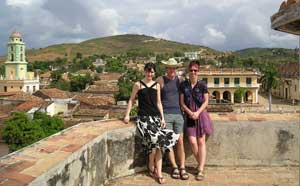
As
the festival ended, I took a bus to Trindad with Zoe and Simon from Ireland.
Not the Trinidad-and-Tobago Trinidad, but a small town in the south of
Cuba, recently made a UNESCO world heritage site and apparently the second
stop for tourists after Havana. Known for its music houses, Trinidad
is very quaint with cobblestoned streets, prettily painted houses lining
the streets, a great swimming beach nearby and a lush valley behind.
Now was the time for sleeping, wandering, stumbling around the dance
floor with the very patient local men, enjoying the luxury of toilet
seats (which are scarce in Santa Clara) and floating on my back in the
Carribean without anything in particular to do. Bliss!
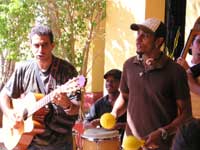 We
met Mercedes Borga and Montimar,
the music group she manages,
and visited her home where her partner Coki gave us a lesson in ceramics.
We took a tourist train into the Valle
de los ingenios and I climbed
the tower at Manaca Iznaga - a huge structure built a couple of centuries
ago by the local oligarch to keep an eye on his slaves in the fields.
I spent quite a lot of time lying on the sand or my bed or drinking mojitos
or beer and reading the guide book, filling in a little bit of the vast
gaps in my knowledge of the history of the country. We
met Mercedes Borga and Montimar,
the music group she manages,
and visited her home where her partner Coki gave us a lesson in ceramics.
We took a tourist train into the Valle
de los ingenios and I climbed
the tower at Manaca Iznaga - a huge structure built a couple of centuries
ago by the local oligarch to keep an eye on his slaves in the fields.
I spent quite a lot of time lying on the sand or my bed or drinking mojitos
or beer and reading the guide book, filling in a little bit of the vast
gaps in my knowledge of the history of the country.
And then I was back in Havana, at the same casa particulare I'd
stayed at before the festival with Jill (who speaks Spanish) and Gilly.
On my own, I was forced to hablar español, and after a week of
having a go in Trinidad I actually managed to communicate with and impress
Alberto, the casa owner. I also managed to get a taxi ride home in a
1959 Chevrolet Impala on my last night, which meant I could leave early
the next morning feeling that I'd had a real Cuban experience.
Back
to top
|
